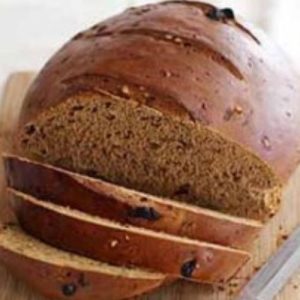
Raisin Walnut Pumpernickel Bread
A soft, moist pumpernickel bread loaded with sweet raisins and crunchy walnuts. Rich in fiber, plant-based protein, and good fats, it’s a wholesome choice for breakfast, sandwiches, or a snack. Quick to prepare and easy to bake, this loaf is perfect for everyday meals or making ahead for the week.
Equipment
- 1 large mixing bowl (or stand mixer bowl)
- Wooden spoon or dough hook attachment
- Baking sheet, 9×5-inch
- Parchment paper
- Tea towel
- Instant-read thermometer
Ingredients
- 1 ¾ cups warm water 100–110°F
- 2 tablespoons granulated sugar
- 2 ¼ teaspoons active dry yeast 1 packet
- 2 tablespoons instant coffee or espresso powder
- ¼ cup molasses
- 4 ½ cups bread flour divided
- 1 cup dark rye flour
- 2 teaspoons salt
- 1 cup walnuts toasted and chopped
- ¾ cup raisins
- 1 egg white
- 3 tablespoons water
Instructions
- Prepare the Yeast Mixture: Start by warming 1 ¾ cups of water until it reaches 100–110°F—warm enough to activate the yeast, but not so hot that it kills it. Pour the water into a large mixing bowl (or stand mixer bowl) and add 2 tablespoons of granulated sugar. Sprinkle in 2 ¼ teaspoons of active dry yeast. Stir gently to dissolve the yeast completely. Let the mixture sit undisturbed for 5–10 minutes until it becomes foamy and aromatic, indicating the yeast is active and ready to work its magic.
- Combine the Wet Ingredients: Once the yeast has proofed and formed a light foam, stir in 2 tablespoons of instant coffee or espresso powder and ¼ cup of molasses. The coffee enhances the deep, rich flavor of the pumpernickel, while molasses adds subtle sweetness and a moist texture. Mix thoroughly until the liquid is smooth and uniform in color.
- Add Dry Ingredients: Gradually add 4 cups of bread flour, 1 cup of dark rye flour, and 2 teaspoons of salt to the yeast mixture. Then, fold in 1 cup of toasted, chopped walnuts and ¾ cup of plump raisins. Use a wooden spoon or the dough hook attachment of your stand mixer on low speed to combine everything into a sticky, shaggy dough. At this stage, the dough should be cohesive but slightly tacky, which will ensure a soft, moist loaf.
- Knead the Dough: Turn the dough onto a lightly floured surface. Knead it with your hands for 10–15 minutes, adding small amounts of the remaining ½ cup bread flour only if the dough is too sticky to handle comfortably. If using a stand mixer, switch to medium speed and knead for about 5 minutes. Your goal is a smooth, elastic dough that stretches without tearing easily. The dough should be slightly tacky to the touch but not stick to your hands.
- Shape the Loaf: Once kneaded, shape the dough into a rough oval that will fit a 9×5-inch baking sheet. Make sure the surface is smooth by gently tucking in the edges underneath. This shaping helps the loaf hold its form during baking.
- First Rise (Proofing): Place the shaped dough onto a baking sheet lined with parchment paper. Cover it loosely with a clean tea towel to prevent the surface from drying out. Turn off your oven and place the baking sheet in the center of the oven, creating a warm, draft-free environment. Let the dough rise until it doubles in size, approximately 30 minutes. This step develops air pockets in the bread, resulting in a light, fluffy interior.
- Preheat Oven and Prepare Egg Wash: While the dough is rising, preheat your oven to 375°F. In a small bowl, whisk together 1 egg white with 3 tablespoons of water to make an egg wash. This will give the loaf a glossy, golden-brown crust after baking.
- Score the Loaf: Once the dough has doubled in size, remove it from the oven and gently brush the top with the prepared egg wash. Using a serrated knife, make three shallow slits about ¼-inch deep across the top of the loaf. Scoring allows the bread to expand evenly while baking and gives it a professional, rustic appearance.
- Bake the Bread: Place the baking sheet in the preheated oven and bake the bread for 35–40 minutes. The loaf is done when the crust is a rich, deep brown and an instant-read thermometer inserted into the center reads 185°F. Baking times can vary slightly depending on your oven, so keep an eye on the color and internal temperature.
- Cool the Loaf: Carefully remove the bread from the oven and transfer it to a wire cooling rack. Allow it to cool completely before slicing—this prevents the interior from becoming gummy and ensures clean slices. The aroma of warm pumpernickel, raisins, and walnuts will fill your kitchen during this time, making it hard to wait!
- Slice and Serve: Once cooled, slice the loaf into 12 even pieces. Serve it plain, toasted with butter, or as a base for sandwiches. The bread pairs beautifully with cheeses, nut butter, or a drizzle of honey for a wholesome snack or breakfast.
Notes
- For best results, use freshly toasted walnuts to enhance flavor and crunch.
- Warm water should be between 100–110°F; too hot will kill the yeast, too cold will slow fermentation.
- You can substitute espresso powder with instant coffee if desired—both enrich the pumpernickel’s deep flavor.
- Rye flour adds a nutty, earthy taste and increases fiber, while bread flour ensures structure and softness.
- Allowing the dough to rise in a warm, draft-free environment ensures a light, fluffy interior.
- Egg wash is optional but recommended for a shiny, professional-looking crust.
- This bread is best enjoyed within 2–3 days at room temperature but can be frozen for up to a month.